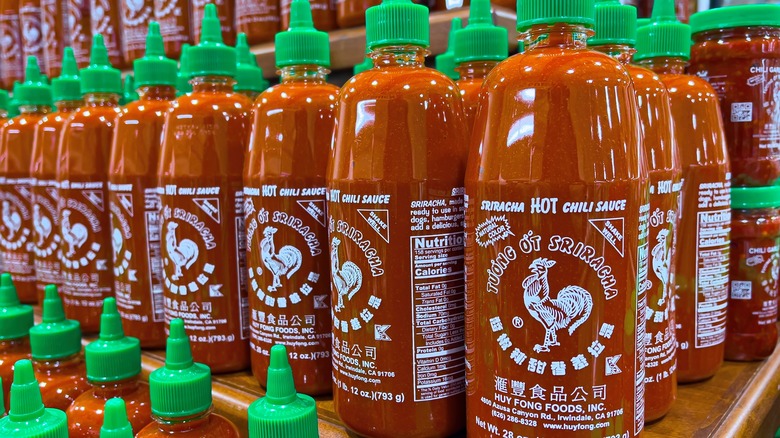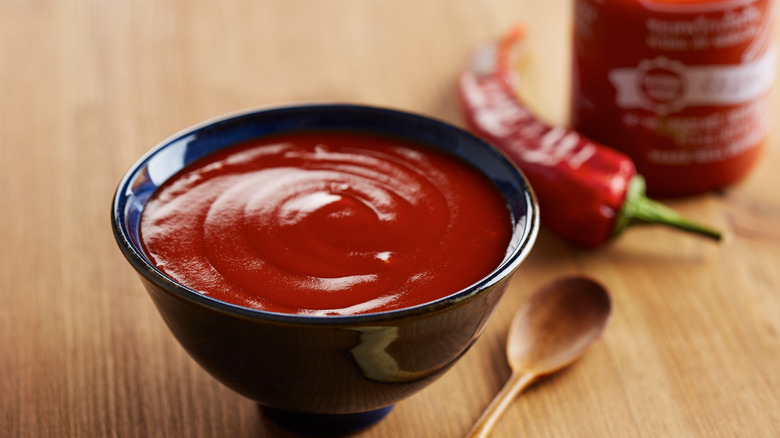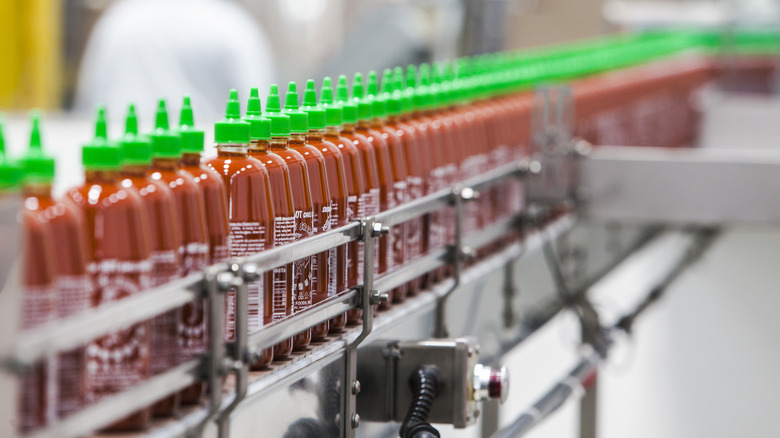How Sriracha Made Its Mark In The US
Whether you love something as easy as a sriracha-lime mayo, as complex as spicy sriracha wontons, or as unique as a caramel sauce with a sriracha kick, there are plenty of reasons to keep a bottle or two of sriracha on hand. In 2022, manufacturer Huy Fong Foods was selling around 10 million bottles a year, and that's made even more impressive when you know that sriracha was only invented in 1949. Huy Fong founder David Tran only started making his version in 1975. Tran and his sauce made the move to the U.S. in 1979, and it didn't take long for sriracha to make a huge impact.
Huy Fong's sriracha bottles are iconic, and it turns out that they're just as personal. Tran named his company after the ship that he took when he left Vietnam. In an apropos footnote, the name translates to "gathering prosperity." That rooster logo is personal, too: Tran was born in the year of the rooster.
Passion for a product isn't enough. In 2015, Tran spoke with East West Bank and shared some of the secrets to his success — aside from his condiment's taste. Simply put, he made his sriracha accessible. Tran explained, "My dream is everyone can have my product — rich man, poor man." For at least 35 years, he didn't increase the wholesale price, and there were no trademark, licensing fees, or advertising costs associated with it. To get the business off the ground, Tran even prepared, packaged, and delivered the sauce himself.
Sriracha went mainstream in a matter of decades
Sriracha had fairly modest origins that have been traced back to a village in Thailand called Sri Racha and a woman named Thanom Chakkapak. In 1949, she started making a sweet sauce with garlic and chilis, and after it became a local favorite, she grew it into a regional business. By 1975, others were making their own versions, and that included the product that was developed by chili farmer David Tran.
It was Tran who would eventually make his way to the U.S. and turn his sriracha into a nationwide phenomenon, but it wasn't a direct route to get there. He and his family lived and worked outside of Saigon, and in 1978, the Vietnam War dragged on, and ethnic Chinese living in Vietnam found themselves targeted by a campaign of harassment, the confiscation of property, and forced relocation. Many opted to leave the country, including Tran. He went first to Hong Kong — traveling on the ship that he would later name his company for — and then, in 1979, he ended up in California.
It was there that he opened Huy Fong. Working alone out of Los Angeles's Chinatown, he filled recycled baby food jars with two spoonfuls of sauce each, which he delivered to customers and sold out of the back of his Chevy van. In those early years, his sales grew by about 20% every year as sriracha's popularity spread — and at first, it spread solely by word of mouth.
Hut Fong Foods has tried to broaden its reach
David Tran's Huy Fong sriracha had steady growth based on the love of dedicated customers, but it really blew up when it became Bon Appetit's 2010 Ingredient of the Year. Huy Fong sold 20 million bottles that year, and they didn't look back. Fast forward to 2021, and the company's California production facility was turning out about 18,000 per hour in order to keep up with demand.
It's worth noting, though, that Tran's success story was initially more of an American one than a global one. It became widely associated with the Asian continent as it spread in popularity across the U.S. Yet it wasn't until the 21st century that Tran's Huy Fong Foods really started to push into the Asian market, where some consumers rejected his version of the condiment as American sriracha. One of the biggest markets was the Philippines, where it's been a massive success.
In 2019, NPR headed to Thailand, where other versions are still made and marketed. It spoke with Saowanit Trikityanukul, the great-granddaughter of sriracha's creator. She recalled helping to pick, prep, and mix the original ingredients for the family's now-famous sauce and shared an opinion about Huy Fong's version that was apparently pretty prevalent in sriracha's homeland: "It's not tasty. It's not mixed together properly. There's only one taste." Who would have thought?


